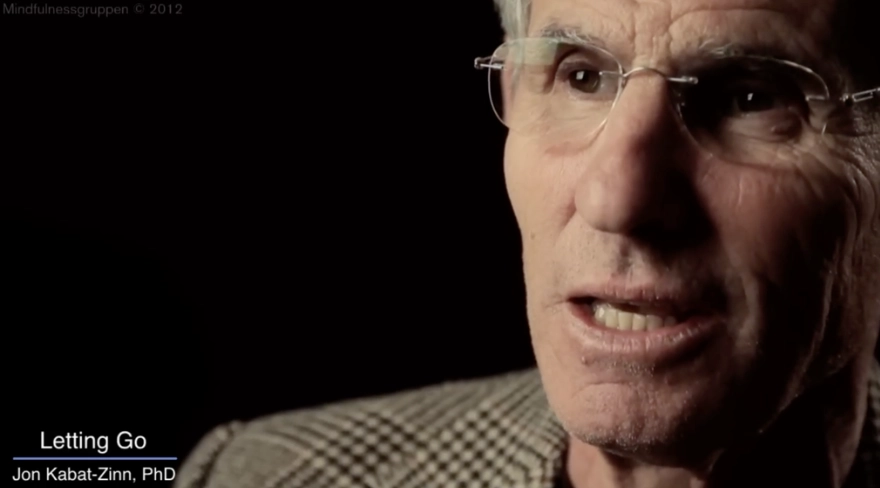從態度開始的正念修習
石世明中譯
2025/4/8
培養「當下的、不加評判的覺察」——聽來似乎很簡單,實際上卻是人生中最困難的功課之一。我們的心容易被慣性與舊有經驗主導,難以真正清楚地看見當下正在發生的事。2025/4/8
當我們練習正念時,帶入某些特定的「態度」是至關重要的。它們幫助我們不去強求、也不追逐特定結果,而是單純地與當下相處。這些態度不僅能支持我們的正練修習練習,也能融入日常生活,改善我們與自己、與他人、與世界的關係。
Jon Kabat-Zinn 最初在《正念療癒之道》一書中提出了七種正念態度,後來補充為九種。每一種態度都是一扇門,通往正念的核心,也通往我們內在更廣闊的生命智慧。
4. Letting Go 放下
Letting go, we could think of as the opposite of clinging or grasping. There’s a certain way in which, when we want something, we grasp it. We cling to it, even if it’s an idea. And very often, we get very fixated in that kind of a way.
「放下」可以被視為「執著」或「抓取」的對立面。當渴望某樣東西時,我們往往會緊緊抓住它,即使那只是一個念頭,也可能讓我們執著不放。我們經常會深陷在那樣的執著裡。
Letting go is reminding us that it's possible to actually not get involved in grasping and clinging to what we want, and trying to push away what it is that we don't want. Because it's inevitable that things will arise that are unpleasant, and we'll want to push those away. And other things will arise and they'll be pleasant. We'll want to hold on to them.
而放下提醒我們,其實我們有可能不被這種抓取所牽引,不必執著於那些我們渴望的事物,也不需要急著推開那些我們不想要的經驗。因為讓人不舒服的情境,總是難以避免地出現,我們會想把它們推開;而讓人愉悅的事物也會出現,我們則會想要緊緊抓住它們。
So letting go really means letting be. It means allowing things to be as they are, and not getting too caught up in having to have them be a certain way when the evidence is they already are not that way. So therefore, not forcing it. Of course, goes with non-striving as well allowing things to be as they are.
所以,「放下」其實就是「讓它如其所是」。意思是,允許事物以它原本的樣貌存在,不再執著於非得讓它變成某種樣子不可—特別是當事實早已顯示,事情根本不是我們所想的那樣。因此,放下就是不強求。這自然也與「不用力追求」相呼應,同樣是在練習讓事物得以如其所是地存在。
In India, they sometimes use a particular way of trapping monkeys. When they take a coconut and cut a small hole in one end. Then they tie the coconut with a wire to the base of a tree, and put a banana inside the coconut. And then monkeys come down from the trees, and they put the hand in the coconut.
在印度,有一種用來捕捉猴子的方式。人們會拿一顆椰子,在一端開一個小洞,然後用鐵絲把椰子綁在樹底,並在椰子裡放上一根香蕉。接著,猴子會從樹上下來,把手伸進椰子裡。
But the hole is crafted so that if you grasp the banana, you can’t get your hand out of the hole. The fist is too big. So you have to let go of the banana to actually release your hand. So the monkeys don’t want to let go, and that’s how they’re trapped.
但那個洞被設計得剛剛好—只要你一抓住香蕉,拳頭就變得太大,伸不出來。因此,你得先放開那根香蕉,才能把手拿出來。但猴子不願意放手,而這正是牠們被困住,無法脫身的原因。
Letting go or letting things be as they are means allowing the recognition that when you are caught by your own desire, by your own attachment to things being a certain way. That’s painful. But letting go is actually the doorway to freedom.
放下,或者說,讓一切如其所是,意味著:我們允許自己辨識出這樣的時刻:當我們被渴望牽引,被對事情「非得如此不可」的執著所困住時,那是一種痛苦的經驗。但放下,其實正是一道通往自由的大門。
And it’s not something that you don't do once. It’s something that you practice over and over and over again, moment by moment by moment. Every time you catch yourself clinging to something, you remind yourself it’s possible to just let it be and to just let it go.
而這並不是一件只需做一次的事,而是需要反覆練習的功課,一刻接著一刻,一次又一次。每當你發現自己又開始執著於某件事時,就提醒自己:你可以讓它如其所是,選擇放手。
The breath can remind us of that too. Because every time we take a breath in, we have to let it go. Otherwise, there’s no room for the next breath. So it's a natural part of life: to receive, and then release. Receive, and let go.
呼吸也會提醒我們這一點。每當我們吸氣後,就必須吐氣,否則,下一口氣就沒有空間進來。這正是生命自然的律動:吸入,然後釋放。接納,然後放下。
「放下」可以被視為「執著」或「抓取」的對立面。當渴望某樣東西時,我們往往會緊緊抓住它,即使那只是一個念頭,也可能讓我們執著不放。我們經常會深陷在那樣的執著裡。
Letting go is reminding us that it's possible to actually not get involved in grasping and clinging to what we want, and trying to push away what it is that we don't want. Because it's inevitable that things will arise that are unpleasant, and we'll want to push those away. And other things will arise and they'll be pleasant. We'll want to hold on to them.
而放下提醒我們,其實我們有可能不被這種抓取所牽引,不必執著於那些我們渴望的事物,也不需要急著推開那些我們不想要的經驗。因為讓人不舒服的情境,總是難以避免地出現,我們會想把它們推開;而讓人愉悅的事物也會出現,我們則會想要緊緊抓住它們。
So letting go really means letting be. It means allowing things to be as they are, and not getting too caught up in having to have them be a certain way when the evidence is they already are not that way. So therefore, not forcing it. Of course, goes with non-striving as well allowing things to be as they are.
所以,「放下」其實就是「讓它如其所是」。意思是,允許事物以它原本的樣貌存在,不再執著於非得讓它變成某種樣子不可—特別是當事實早已顯示,事情根本不是我們所想的那樣。因此,放下就是不強求。這自然也與「不用力追求」相呼應,同樣是在練習讓事物得以如其所是地存在。
In India, they sometimes use a particular way of trapping monkeys. When they take a coconut and cut a small hole in one end. Then they tie the coconut with a wire to the base of a tree, and put a banana inside the coconut. And then monkeys come down from the trees, and they put the hand in the coconut.
在印度,有一種用來捕捉猴子的方式。人們會拿一顆椰子,在一端開一個小洞,然後用鐵絲把椰子綁在樹底,並在椰子裡放上一根香蕉。接著,猴子會從樹上下來,把手伸進椰子裡。
But the hole is crafted so that if you grasp the banana, you can’t get your hand out of the hole. The fist is too big. So you have to let go of the banana to actually release your hand. So the monkeys don’t want to let go, and that’s how they’re trapped.
但那個洞被設計得剛剛好—只要你一抓住香蕉,拳頭就變得太大,伸不出來。因此,你得先放開那根香蕉,才能把手拿出來。但猴子不願意放手,而這正是牠們被困住,無法脫身的原因。
Letting go or letting things be as they are means allowing the recognition that when you are caught by your own desire, by your own attachment to things being a certain way. That’s painful. But letting go is actually the doorway to freedom.
放下,或者說,讓一切如其所是,意味著:我們允許自己辨識出這樣的時刻:當我們被渴望牽引,被對事情「非得如此不可」的執著所困住時,那是一種痛苦的經驗。但放下,其實正是一道通往自由的大門。
And it’s not something that you don't do once. It’s something that you practice over and over and over again, moment by moment by moment. Every time you catch yourself clinging to something, you remind yourself it’s possible to just let it be and to just let it go.
而這並不是一件只需做一次的事,而是需要反覆練習的功課,一刻接著一刻,一次又一次。每當你發現自己又開始執著於某件事時,就提醒自己:你可以讓它如其所是,選擇放手。
The breath can remind us of that too. Because every time we take a breath in, we have to let it go. Otherwise, there’s no room for the next breath. So it's a natural part of life: to receive, and then release. Receive, and let go.
呼吸也會提醒我們這一點。每當我們吸氣後,就必須吐氣,否則,下一口氣就沒有空間進來。這正是生命自然的律動:吸入,然後釋放。接納,然後放下。


